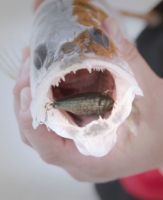Be Loud, Be Heard on the Ice
Category: article
Nov 3rd, 2010 by OutdoorsFIRST
Modified Nov 3rd, 2010 at 12:00 AM
Most ice fishermen choose a serene approach, fearing they might spook away fish that are already chilly and lethargic. Their main tactic is to use small baits to convince lethargic walleyes and panfish to bite.
Not Jon Thelen. The fishing guide, former walleye tournament pro, TV host, and Lindy Fishing Tackle pro staffer is LOUD on hard water. He uses vibrating, rattling, glowing baits designed to call fish from a distance and to provoke reaction strikes from walleyes, perch and crappies whether they’re hungry or not. Vibration, rattles and bright colors do the trick when subtler approaches are ignored.
“This isn’t normal ice fishing,” says Thelen, “where you watch them come in on the flasher and just look at the bait. These fish rush in and whack it. They might be cruising by or belly down on the bottom, but they come tearing in.”
His walleye setup includes 10/2 braided line (10-pound-test breaking strength, 2-pound diameter), tied directly to a noisy bait like Lindy’s new Darter, a lure that Thelen says acts more like a crankbait he can ‘cast’ under the ice. Where jigs will essentially rise and fall directly below the hole, the Darter is true to its name and darts out a couple feet to the side when he snaps it 6 to 12 inches off the bottom.
The braided line helps transmit more of the power of the lift from his wrist to the bait. In contrast, monofilament, with its tendency to stretch, would absorb too much of the force. The bait’s action would be dampened.
Snap the Darter again and the bait shoots two feet to the other side, then another. The result is that the Darter covers a circle four feet in diameter below the hole.
At the same time, the vibration and rattles send out sound waves to the surrounding area. The bait uses noise and gathers scarce light in dark conditions which is common in winter. Winter is when daylight is at its shortest and ice cuts the intensity of light even more.
While other anglers are drilling hole after hole to drop jigs directly below them, Thelen is calling active walleyes to him.
Another advantage of this aggressive approach: Thelen doesn’t have to focus solely on the low-light times when walleyes are ready to eat. The vibration and rattles and the Darter’s holographic paint job can provoke reaction strikes all day long. In addition, the Darter features truly realistic, baitfish patterns.
 |
|
|
Darter Walleye
|
“I’m finding that, in basins during the day when no one else is catching fish, this really turns them on,” says Thelen.
Glow colors, red and chartreuse, extend action well past the ‘golden hour’ at sunset.
Thelen is from Minnesota. The lakes he fishes are natural lakes. The best walleye locations focus on structure, whether they are points associated to the shoreline or mid-lake humps and islands.
Edges are important. Indeed, anglers focus on drops as subtle as a foot or two, or sharp breaks from 30 to 35 feet on lakes like Mille Lacs and Lake of the Woods.
But Thelen has a notion that, although fish travel along edges, they spend more time either feeding on top of the structures during the low-light times or back away from the edges in deeper water during the day when they are inactive. So while edges get the fishing pressure, Thelen is on one side or the other of the edge, mostly on top where active fish are feeding, to create a longer window of opportunity.
He’ll cut a hole and take a look down with his sonar. If he sees fish, that’s great. But even if he doesn’t, he has confidence enough in these tactics to lower a loud lure down the hole and make noise a few minutes to see what appears. If nothing, he cuts another hole and another. Still nothing, he makes a big move. The noisy bait has eliminated the nearby water. So, he moves to another side of the structure and tries again.
“The whole idea,” he says, “is to have something erratic and loud to bring them in. If the school of fish is 30 feet to the right, you can’t see them. This will bring them in. This will greatly eliminate search time on the water.”
Attempt the same strategy with a jig, thinks Thelen, “and they might not even see it.”
If the prime time is only going to last for 45 minutes to an hour, Thelen doesn’t want to be spending precious moments drilling holes when one, well-placed hole, with a loud bait will do the trick and cover the same amount of water. One hole versus many holes. Which one is more efficient? “We maximize the bite window,” he said.
Granted, not every fish wants an aggressive approach. Thelen uses a simple slip-bobber rig and lowers a Frostee Jig tipped with a lively minnow down a second hole for them. On really tough days, he may switch to less aggressive bait like a Rattlin’ Flyer Spoon on the main line.
The Darter comes in four sizes: 1-1/3 inches, 1-3/4 inches, 2 inches, and 2-3/4 inches. Sometimes, perch will show up and take the ‘walleye’ bait. When that happens, Thelen switches from the larger size Darter to the smaller and has a great time plucking tasty panfish from the water.
If crappie are his preference, he’ll head to deeper holes in the deepest part of the lake and jig up a few of those on small Darters.
The moral of this story: Quit acting like a timid schoolboy in a library. Next time you go ice fishing, be LOUD.
DARTER VIDEO, Pelican Lake Pike Strike!!